Create the map walking
This story is about a small project "walking Street", which aims to help people to comfortable move around the city. The current phase of the project — a very early prototype showing some ideas and possibilities. At the same time, I decided to publish it to gather feedback from the external world and associates.

I still like the cards and I love them and tell you about them, and even sometimes something sometimes with cards do. And now the story also is about the mapping service.
Making the city fit for comfortable movement on foot and that makes walking around the city comfortable and pleasant? To find answers, I asked a group of people to describe their experience of the walks and to share what is important to them when they are not in much hurry, and would like to walk around the city.
It turned out that it is important the following options:
the
Thinking further, we (I and a group of caring friends to whom I told the idea) came to the conclusion that to help pedestrians from two sides simultaneously: to improve the urban space, making the environment more comfortable or to create services for pedestrians, helping to make their walk comfortable. However, it usually starts with the analysis and clarification of the current situation. So the idea came to do in the first stage, a Toolkit for interactive exploration of the urban environment.
The first prototype of the service was such:
In the first version of the prototype used fictional data for multiple environment settings. Main idea: the convenient interface of the study area and selection of locations according to the parameters that are relevant to each person.
A few words about how I made this prototype:
the
After testing the first prototype on friends, it was decided to modify this concept and the next step is to use real data. Still, it became clear that in the early stages is to abandon poorly measured parameters, because some of the properties of the street people perceive in different ways: someone she feels comfortable, and some don't. In the future these indices will be added, but they will have to rely on user ratings within a sufficient number of user ratings.
I really wanted to the information for the project was public and available to anyone could add important information for him to experiment with the data and explore them yourself.
Where to get the real data? Such open data that were needed by the people, yet, and so we will collect them on their own, and in order to not only deal with data collection and still manage to do something interesting, we limited the study area the two parts of the areas of Yakimanka and Zamoskvorechye district within the Garden ring.
 Set of the researcher of the urban environment
Set of the researcher of the urban environment
The most appropriate base for the project was OpenStreetMap, in addition to the set of available tools and technologies, every pedestrian in the city there is the ability to mark or Refine the analyzed data, the OSM map is created and edited by users.
In the end, after a series of field studies and experiments, we have collected some parameters about urban streets and we got a small interactive project with real data, which we call "walking Street"
The project tells 4 stories about the city in the investigated area: the width of sidewalks, accessibility of the environment (building entrances, staircases), the noise on the street and interesting places.
Now this is not a complete custom service that would solve all problems comfortable moving around the city, rather, it is a slightly more elaborate version of the prototype, which we published with the aim to collect feedback, find out what points to study in more detail or alter.
About each data slice will tell you more:
the
Almost all the services we used to enjoy, it is understood that indicated on the map the street is impassable on foot. In reality it is not. The sidewalk is not always the case on both sides, sometimes it suddenly stops, sometimes it can be very narrow and uncomfortable.
We decided to tell a story as wide in our chosen area of sidewalks and have created a special map of sidewalks. On a narrow sidewalk (width less than 1 meter) it is inconvenient to break up with opposing passers, but if you walk with company, to communicate and to move in single file also, in General, uncomfortable.

We have identified several categories according to the width of the sidewalk, and showed on any of the sidewalks what kind of company you can comfortably walk. Click on the map for each selected pavement you can find a specific width.
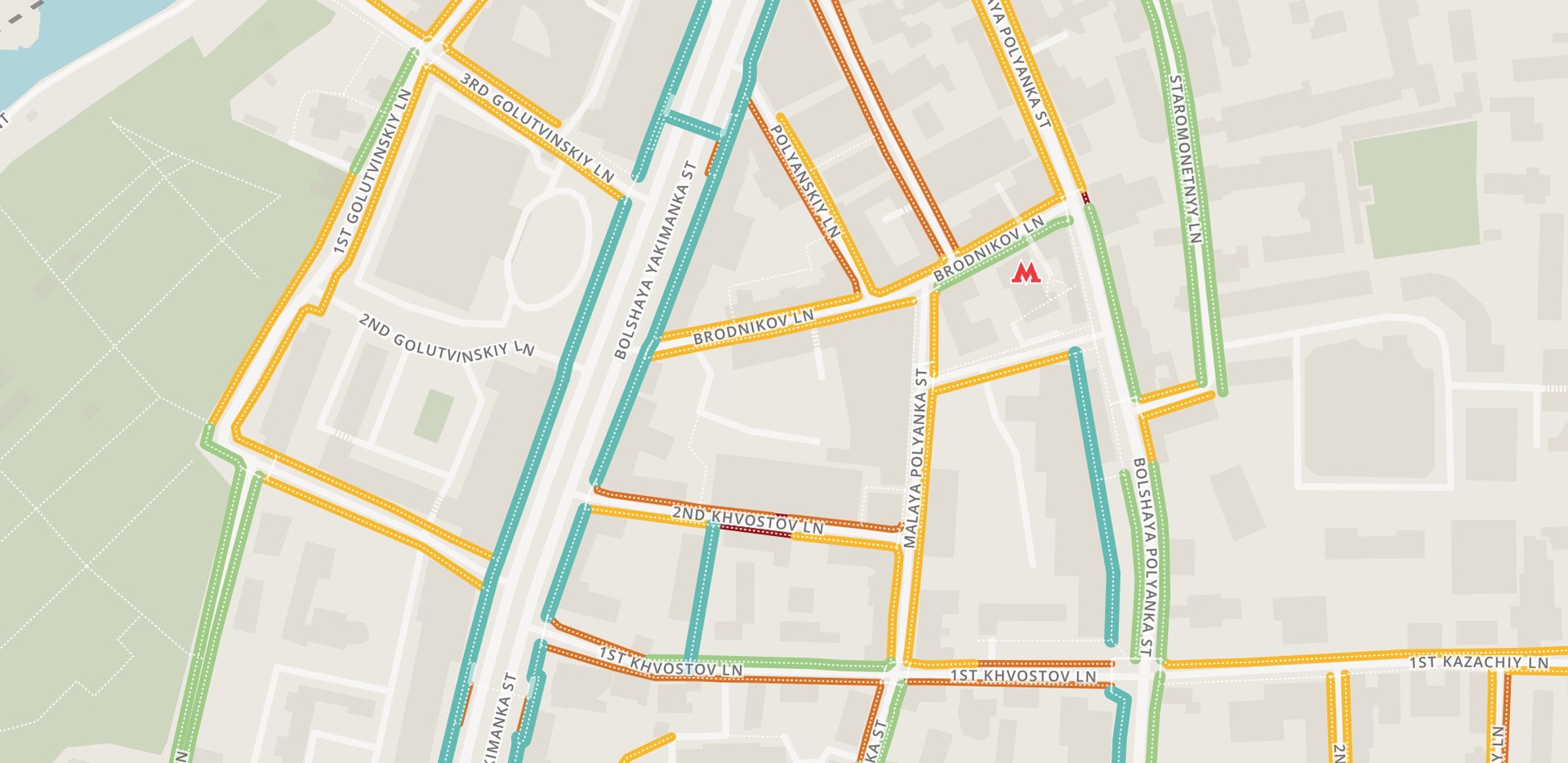
Map of sidewalks
In the Central areas with historical buildings many narrow streets and the sidewalk may be purely symbolic. We found several places where the sidewalk suddenly narrows to a few tens of centimeters, you can find these places on the map. At the time of the study Bolshaya Ordynka was reconstructed and was like a building site, it was difficult and uncomfortable to move.
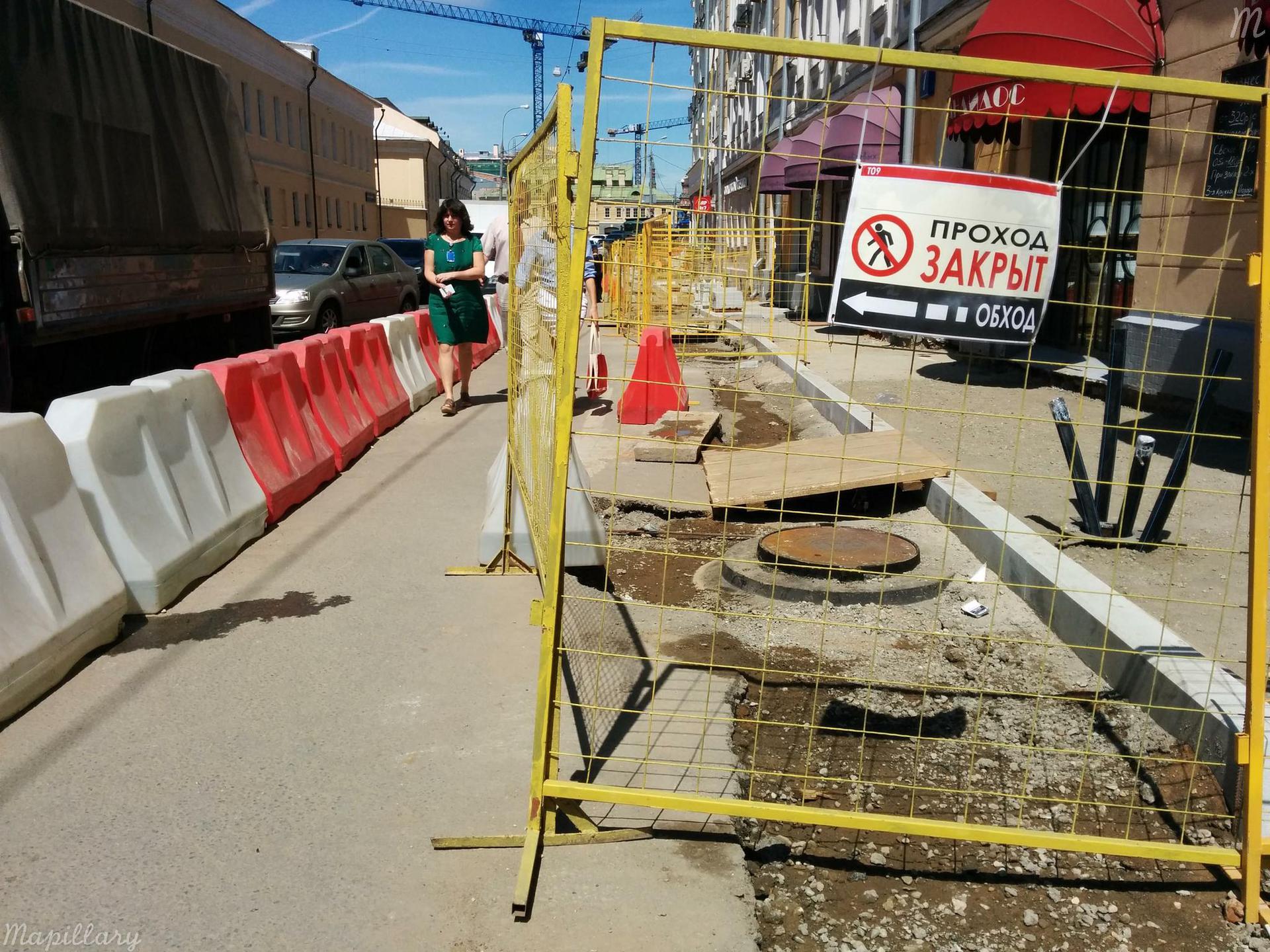
the reconstruction of the sidewalk on the Big Ordynka, July, 2015
In the course of collect data on the sidewalks, the route was photographed c applications Mapillary. In sidewalks through the API loadable out the next photo to show the actual condition.
Now we know about 92 kilometers of sidewalks and their width. In the investigated area the average width of a sidewalk of 2 meters 18 centimeters. Expect wide sidewalks in the area were on the street Bolshaya Yakimanka — wider than 5 meters each, it's a big street. In the historic streets sidewalks traditionally narrow, averaging 1-1.5 m. However, there were a few small streets where the sidewalk is wide enough and comfortable. For example, novokuznecka, Tatar and Bakhrushin, Malaya Ordynka alleys Staromonetny, pyzhevskii, half of the 1st Spasonalivkovsky and Kazansky lanes.
the
It is about citizens with limited mobility: wheelchair users and young parents with prams. We have created an accessibility map in the studied by us area.
For people with disabilities environment requirements higher, and if mother with a pram one or two low steps is not very big obstacle, though, and is also unpleasant for people with disabilities it is often an insurmountable obstacle.
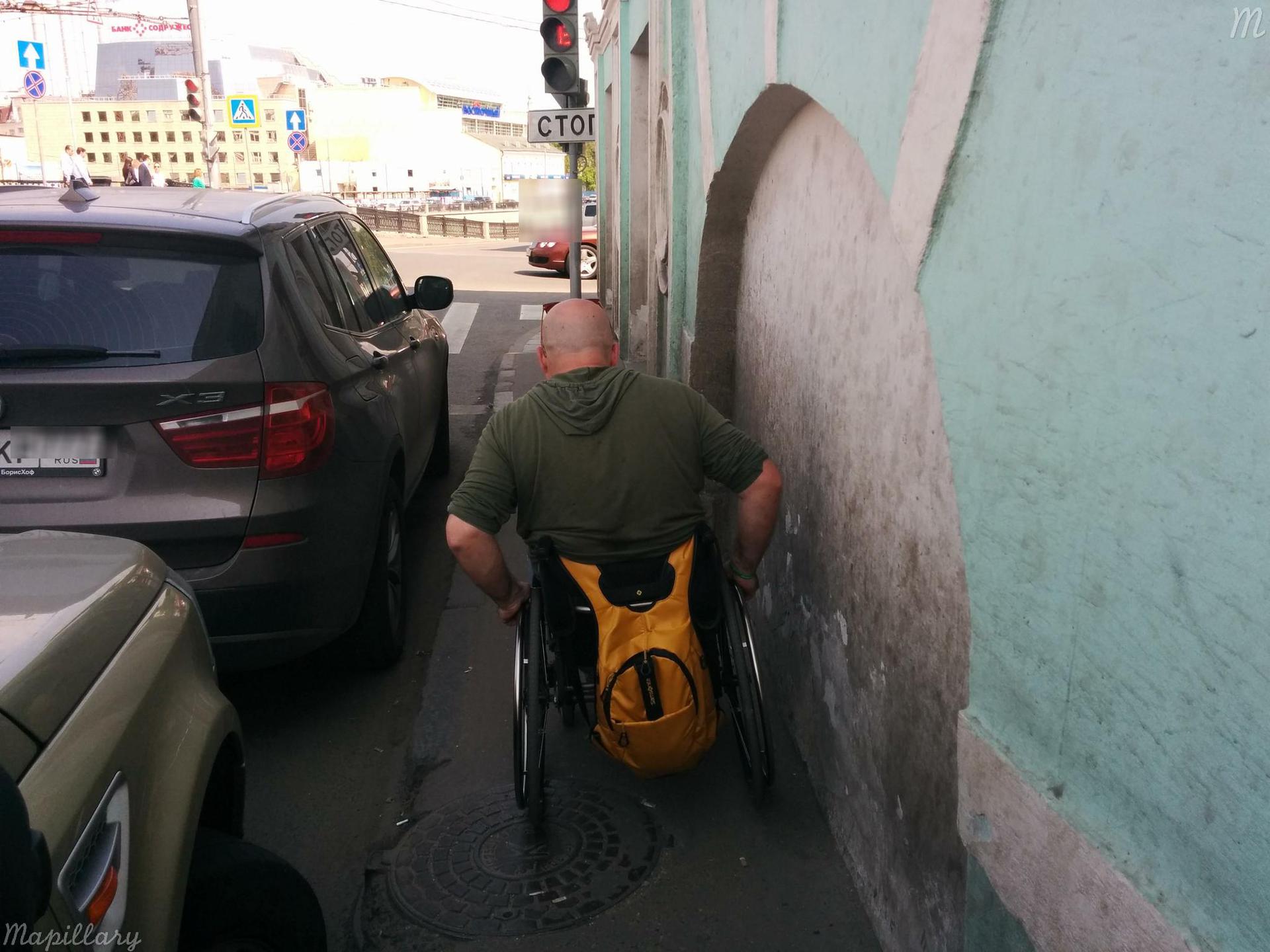
Igor and narrow sidewalk on Kadashevskaya embankment
Igor Gakov:
The same applies to travel with a pram. After a couple of walks with the stroller to change the perception of the city and the route of movement. Worth a try at least once — it's definitely an interesting experience.
Evaluating the accessibility of establishments we started checking the entrances to the institution and the building, using three categories:
"Available" (green) — at the entrance or there are no steps higher than 7 cm, or the owners have taken care to mount a convenient ramp. The opening width of an entrance door not less than 60 cm.
"Partially available" (yellow) — one or two steps at the entrance or a low curb in a wheelchair, most likely, in this place without assistance to get there, and with a pram it is possible to sneak.
"Unavailable" (red) and with a pram and a wheelchair to the school to penetrate difficult. In this category fall companies and places at the entrance in which you expect steep stairs without a ramp or high porch, you either need to walk up or down stairs to another floor.
In the studied area we checked 203 places and found that 103 of them are not available (50.7%), 68 — partially accessible (33.5%), and only 32 places available for people with limited mobility (15.8%).
Another serious obstacle — the stairs of subways and street stairs. On issledovana area there are seven underpasses: three on the Big Yakimanka and four great transition to the Garden ring. Transitions on Yakimanka is equipped with comfortable ramps with no steps, and it is available to people in wheelchairs. And from the passages on the Garden ring can be considered adapted for disabled people only go to Paveletskaya: in other places step subways equipped with convenient ramps.
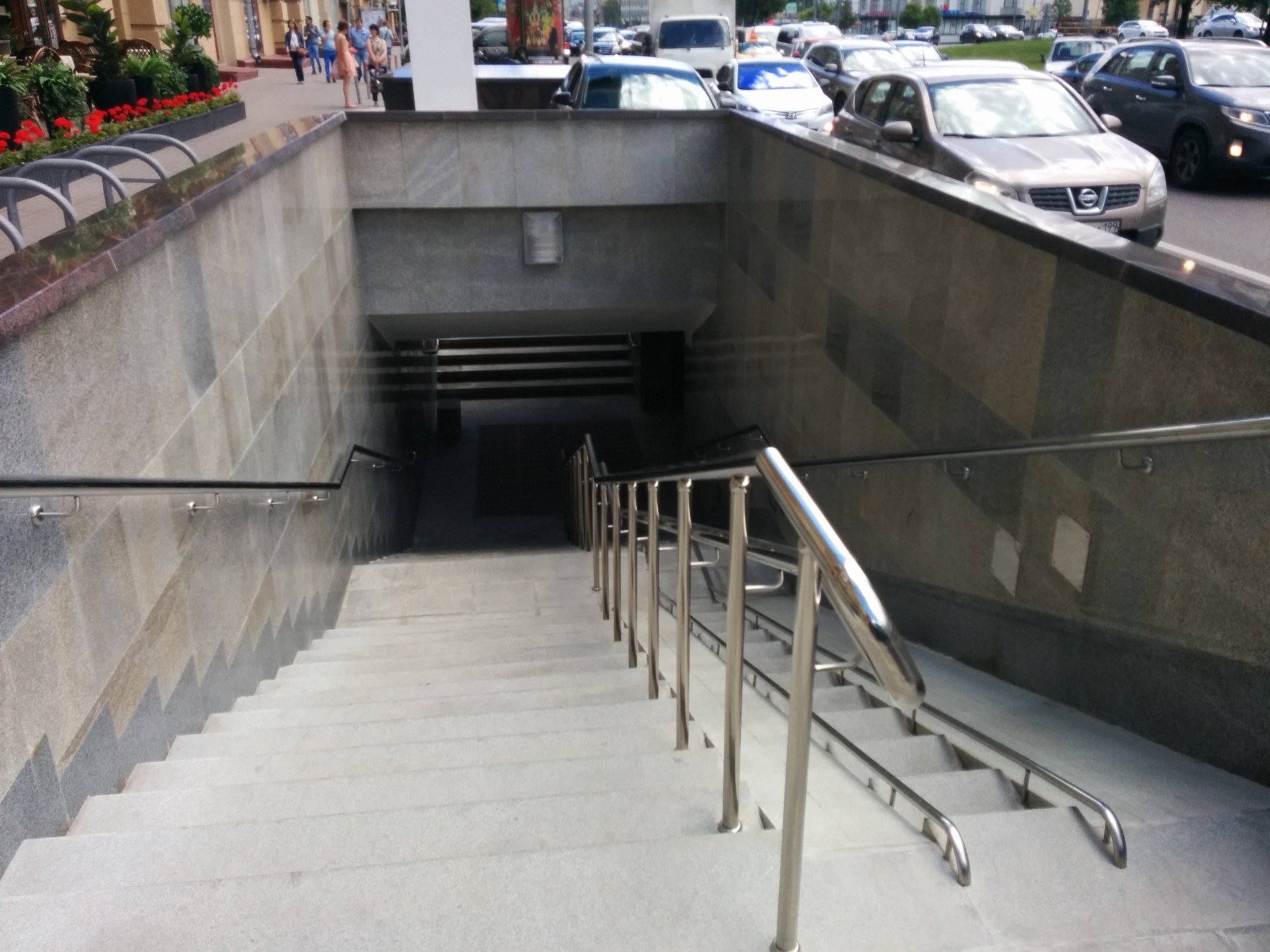
As for sidewalks, for the objects we display photos of the nearest location of the Mapillary.
At this stage, were not considered high curbs and other obstacles on the sidewalks, but it is in the plans. We also plan to learn how to build Hiking trails with regard to the data on the availability of protection. For example, in Saint-Petersburg guys are already doing this service.
the
As noted by the people in the survey — the ability to walk in a quiet and peaceful location plays an important role for comfortable movement on foot. Sources street noise various: construction, vehicular traffic, public transport or crowds.
In practice, studies of the urban environment is being actively used noise mapping — but this is a fairly labor-intensive method: you need to count all sources of noise and to build an accurate model.
In the first stage, we decided to go a more simple way, and made a series of point measurements of noise level, walking around the city. In General, measurements were made on weekdays, in the period of 9 am to 19 PM.
Data on noise was collected using a InstaDecibel. This app allows you to track each measured with a photo, explaining when it was made the measurement and what the terrain. All the measurements we published in a special Instagam account.
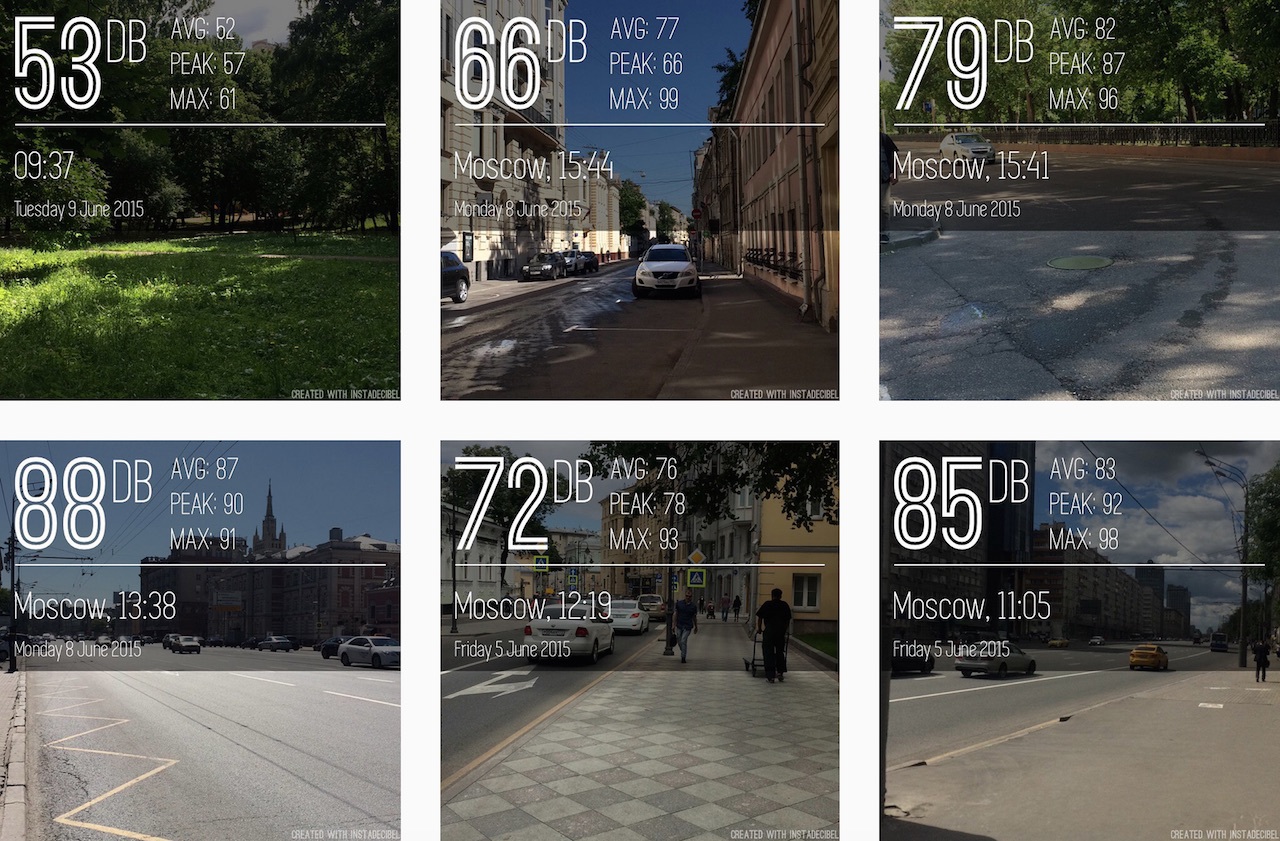
In the end, it turned this map noise:
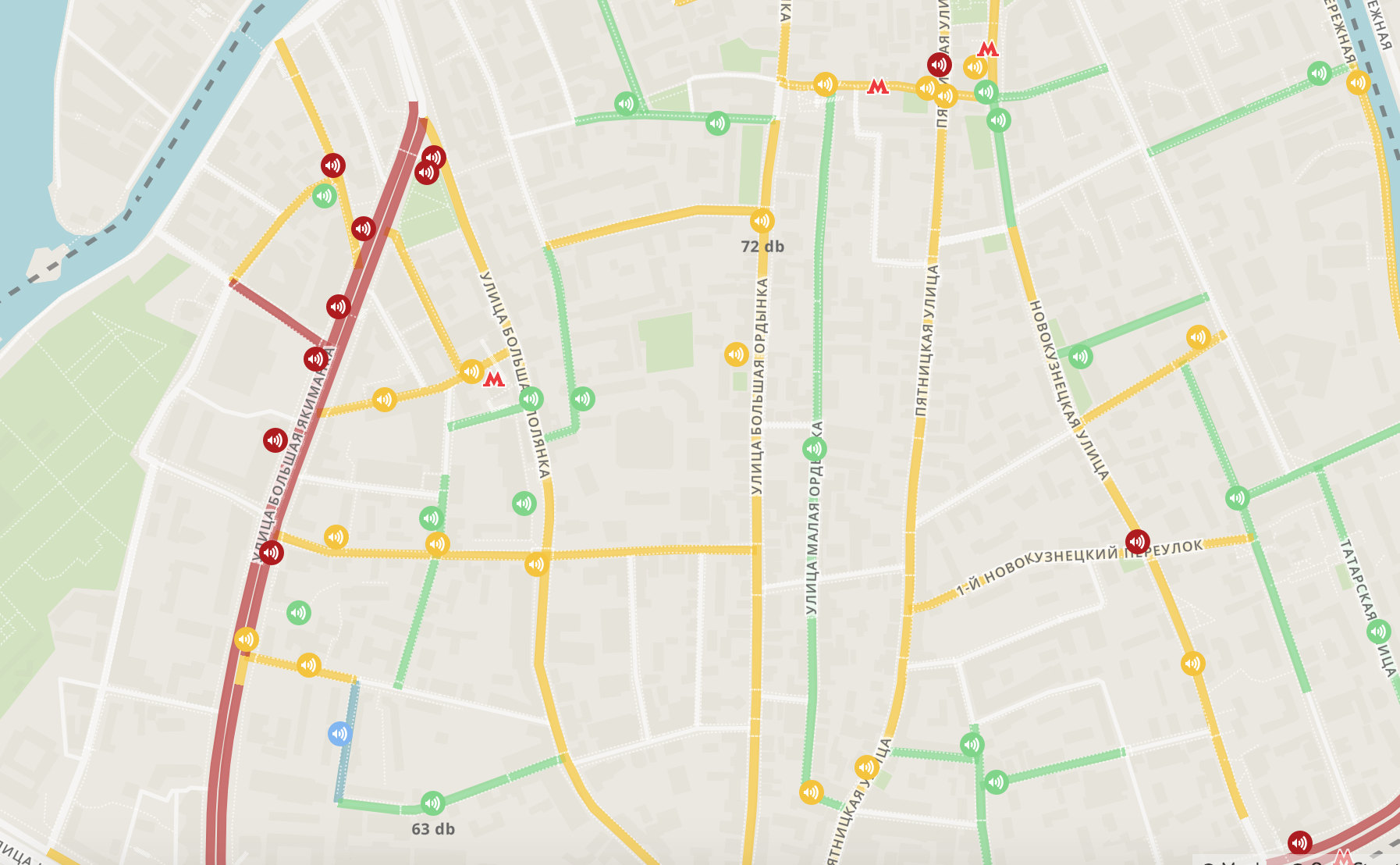
Less than 60 dB (blue) in the center is rare, you need to look for a very quiet courtyards and small streets, where occasionally passing cars and there is a dense traffic street noise — 60-70 dB (green): it is possible to communicate, listen to music.
On the streets a bit larger where the more cars or in pedestrian zones with high concentration of people (for example near the metro station Tretyakovskaya) the street noise is kept at 70-80 dB. In such circumstances, in a quiet voice talk is not really work.
On large highways consistently a lot of cars, so the noise level in an active time above 80 dB. It is an uncomfortable conditions for walking.
We are thinking of how to organize the measurements of noise in the future collectively and experimenting with the options.
the
There are countless guides with collections of interesting places. Usually such collections are experts. We decided to experiment and find open data about interesting places and automatically make a selection for our area.
Says Philip Katz:
"In the current Internet, dozens of sources available POI (points of interest), starting with a great base Foursquare. However, the sources of relevant data under an open license, of course, much less. In our case, a great source is Wikipedia.
The use of Wikipedia as a source of GEODATA is very interesting. The only way we found that there are articles about places in the city are written only in foreign languages; in other words, some things about Moscow English speaking user simply will not be able to read these data as if hidden from us, while remaining available, for example, connoisseurs of Norwegian (or rather, those who use this segment of Wikipedia for queries on Moscow). It would be interesting to explore how many of these ‘hidden’ spots in different cities around the world and what they actually tell. However, articles with a large number of translations, language clusters, the correlation and spatial language and temporal coordinates, the editing history of geolocation — all this is fraught with a large field of opportunities for the development of the project.
Wikipedia, as we know, has no API, offering instead easily collect data directly from web pages. At the same time, the resource has a massive archive of different metrics and data, including full dumps in several formats. We used JSON format.
I must say that the data model is quite exotic: each page (item) consists of an unstructured set of 'statements' (statement) and an array of internal references to the same article in other languages; to read about the model details here.
Although the option to download everything in one file and it seems simple, it contains a problem: desktop is not ready to ugrojat in RAM full dump, weighing about 20 GB and then and read it. For "streaming" file, i.e. read it line by line, keeping only a few lines in memory at any given time, I have used a great module ijson from Ivan Sagalaev.
Further work was not very complicated – for each page in Wikipedia, I check to see if it has attributes of location, and if there is — don't lie whether they are in the interests of my range. If it hits, I'll keep her Russian name and a link, and if it's not English (if the language suddenly, also not, is stored first in the queue). To make life easier, I also set up a simple categorization the most common type of page — the streets, convents and churches, squares and museums, etc. are recognized by ACC. words in the title. In addition, I mark articles without the Russian version (about Moscow! Such accumulated several dozen), and believe in a separate column the number of languages of translation of the article. Processing the entire database took the night — by morning a small csv with 7 thousands of POI.
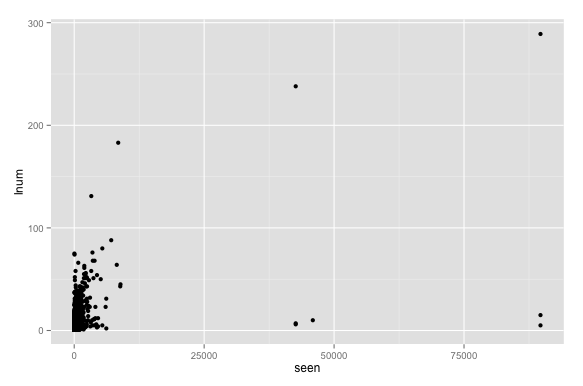
the X Axis, the number of article views per month; Y — the number of languages articles (June, 2015).
The last step is ranking. In order to simplify operation of the server, using basic R command, build a histogram of site statistics and see if you can find a visible cause for categorisation. It is not difficult — the bar chart clearly shows the levels of the articles 'universal' (for example, the article 'Russia', showing the latitude and longitude of the capital), with statistics of more than 75,000 views per month. By a large margin is the second group of elements is slightly less universal (e.g. 'Moscow') having more than 2000 hits, and then, in the beginning, from zero to 500 views gets the bulk. Based on the histogram, they were still divided into three groups: up to 100, up to 500 or more. A total of 5 ranking point values. The data is ready to use.
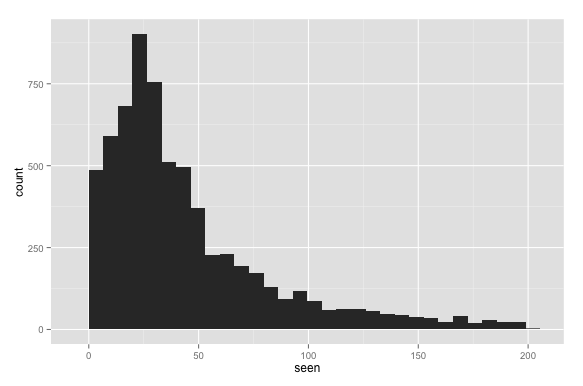
the Histogram statistics of articles with coordinates in Moscow
In the study area, there are very large categories and therefore the categories of popularity got only four marks on the map in four sizes. Later, we visualize these data on the whole city."
As the Wikipedia article with coordinates most often about popular places, the most successful illustration of each object were the photos of Panoramio.
the
For those who have read this far: Surprise! The project does not have its own backend. We use cloud-based data Mapbox, and the entire project is a static page which uses several APIs.
How it all works.
The biggest job in the project — preparation of data and their preprocessing. The environment for this I have collected on the local computer where the data was filled in Postgres where I just used the GeoJSON format.
For example, the width of the sidewalks [width] — standard tag roads in OpenStreetMap, so you can use any dataset Planet.osm. Here, for example, the availability of seats uses the tag [wheelchair], which in Planet.osm is not, so I used Overpass-turbo to load data from OSM.
An indispensable tool for viewing and working with any geodatabase formats — Quantum GIS, I about it already told screencast about the visualization of GEODATA.
For processing Wikipedia data, Philip has developed a special Toolkit WikiGeoParser
The prepared data is imported into Mapbox. To do this, use Mapbox Design Studio:
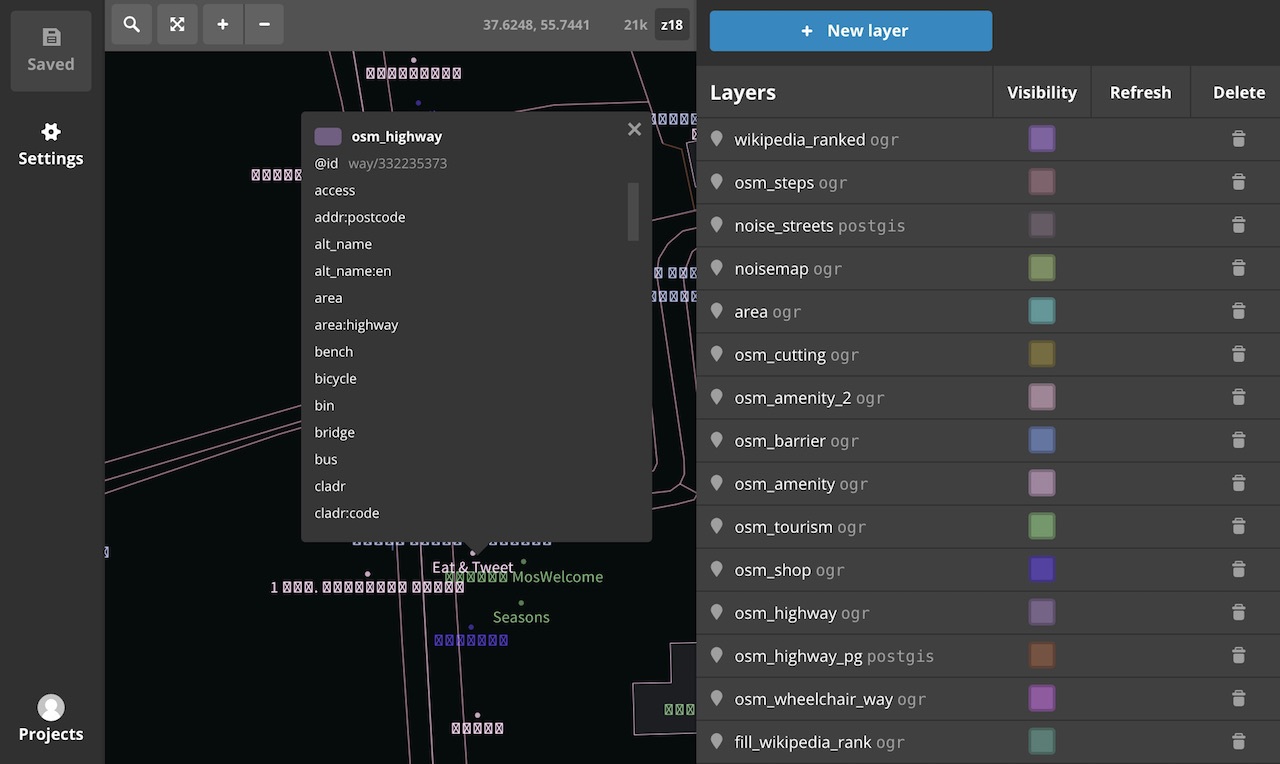
Working with data in Design Studio
To display the imported data API Mapbox GL for Java Script. And the switch card uses the switching classes for the map style, as this example.
Out of habit, to control the DOM on the page I used the familiar to me D3.js (I'm not pretender, so I can be strange).
From UX-chips, typical mapping projects, it is worth noting the memorizing of the current state of the map (I use the location.hash). So you can always copy the URL from the address bar and share the desired fragment of the map with the currently selected mode.
In fact that's all there is. A simple JavaScript application in the browser.
Not very slim not development project code published on GitHub :)
the
The project "walking Street" just begun, and the current version is not the final user of the service, and only an early prototype, interactive story about current travel conditions on a small plot of land. We continue to experiment.
In the nearest plans: to expand the study area to the center of Moscow, and to begin to develop service pedestrian routing, taking into account the studied characteristics of the city.
Now we need help on two fronts:
the Collection and correction of data:
We need to OpenStreetMap data is small, but has all the tools and possibilities of their mark.
You can help the project with data markup on the sidewalks and accessibility of the environment: it needs just a little around the city to enter data in the OpenStreetMap project. To make it easier to deal with this — we have prepared detailed manual about data collection, and to coordinate data collection efforts, we started group Facebook.
Even if you are not in the center of Moscow and are willing to help with other areas and cities — help! I hope we'll be able to expand the project area in the future. These data will be useful not only to us but to all OSM projects that will use them. You can do something interesting with the data collected.
According to first reviews after the launch of the prototype we found that a lot of people want to help with collecting data about the noise level on the street. Soon we'll figure out a solution, as it would be possible to collectively gather these measurements.
If you don't really want to deal with the edits in OpenStreetMap will be useful if you're just going to take pictures of sidewalks using Mapillary — this will help the members of the OSM community to mark the map more accurate.
Backend/infrastructure:
There are two hot tasks that I want to do in the near future:
— Now update data arranged in the primitive and is in manual mode, I perezalivat files and update the local database. Need to automate
— Make the service more useful than just a map with layers of data we want to run pedestrian routing considering the collected parameters of the urban environment.
We are looking for backender. If you are a developer (C++, Python, Node.js, Postgres), who wants to join the project team — please write me karmatsky (at) gmail.com and discuss conditions of cooperation.
The plans — a lot of different experiments with open GEODATA in large volumes and adding new layers.
It would be great to receive any feedback about the project and to discuss project ideas in the comments.
Comfortable you walk!
Project team: Andrew karmatskikh, Philip Katz, Igor Gakov. Thanks for the tips Ilya Zverev and Timothy Samsonov.
Development and design: Urbica — the design Studio, specializing in interactive projects about the urban environment.
Article based on information from habrahabr.ru

I still like the cards and I love them and tell you about them, and even sometimes something sometimes with cards do. And now the story also is about the mapping service.
Making the city fit for comfortable movement on foot and that makes walking around the city comfortable and pleasant? To find answers, I asked a group of people to describe their experience of the walks and to share what is important to them when they are not in much hurry, and would like to walk around the city.
It turned out that it is important the following options:
the
-
the
- the presence of trees, greenery on the street; the
- have on the way you could eat or drink a Cup of coffee; the
- fewer people and cars, quiet street; the
- the ability to see something interesting or learn something new along the way; the
- wide and smooth sidewalk.
Thinking further, we (I and a group of caring friends to whom I told the idea) came to the conclusion that to help pedestrians from two sides simultaneously: to improve the urban space, making the environment more comfortable or to create services for pedestrians, helping to make their walk comfortable. However, it usually starts with the analysis and clarification of the current situation. So the idea came to do in the first stage, a Toolkit for interactive exploration of the urban environment.
The first prototype of the service was such:
In the first version of the prototype used fictional data for multiple environment settings. Main idea: the convenient interface of the study area and selection of locations according to the parameters that are relevant to each person.
A few words about how I made this prototype:
the
-
the
- , I took site GIS-Lab OpenStreetMap data the
- Proportional them to the local Postgres database using osm2pgsql
- Took TileMill from MapBox, stylized map and visualized the parameters of the streets, imported tiles in the account on Mapbox the
- Sketched a static page with a map Mapbox.js the
- For photos of the places I used API Panoramio and popular destinations
Added to the tables I'm interested in field settings and Nabeul "fish" data the
After testing the first prototype on friends, it was decided to modify this concept and the next step is to use real data. Still, it became clear that in the early stages is to abandon poorly measured parameters, because some of the properties of the street people perceive in different ways: someone she feels comfortable, and some don't. In the future these indices will be added, but they will have to rely on user ratings within a sufficient number of user ratings.
I really wanted to the information for the project was public and available to anyone could add important information for him to experiment with the data and explore them yourself.
Where to get the real data? Such open data that were needed by the people, yet, and so we will collect them on their own, and in order to not only deal with data collection and still manage to do something interesting, we limited the study area the two parts of the areas of Yakimanka and Zamoskvorechye district within the Garden ring.
The most appropriate base for the project was OpenStreetMap, in addition to the set of available tools and technologies, every pedestrian in the city there is the ability to mark or Refine the analyzed data, the OSM map is created and edited by users.
In the end, after a series of field studies and experiments, we have collected some parameters about urban streets and we got a small interactive project with real data, which we call "walking Street"
The project tells 4 stories about the city in the investigated area: the width of sidewalks, accessibility of the environment (building entrances, staircases), the noise on the street and interesting places.
Now this is not a complete custom service that would solve all problems comfortable moving around the city, rather, it is a slightly more elaborate version of the prototype, which we published with the aim to collect feedback, find out what points to study in more detail or alter.
About each data slice will tell you more:
the
Sidewalks
Almost all the services we used to enjoy, it is understood that indicated on the map the street is impassable on foot. In reality it is not. The sidewalk is not always the case on both sides, sometimes it suddenly stops, sometimes it can be very narrow and uncomfortable.
We decided to tell a story as wide in our chosen area of sidewalks and have created a special map of sidewalks. On a narrow sidewalk (width less than 1 meter) it is inconvenient to break up with opposing passers, but if you walk with company, to communicate and to move in single file also, in General, uncomfortable.

We have identified several categories according to the width of the sidewalk, and showed on any of the sidewalks what kind of company you can comfortably walk. Click on the map for each selected pavement you can find a specific width.

Map of sidewalks
In the Central areas with historical buildings many narrow streets and the sidewalk may be purely symbolic. We found several places where the sidewalk suddenly narrows to a few tens of centimeters, you can find these places on the map. At the time of the study Bolshaya Ordynka was reconstructed and was like a building site, it was difficult and uncomfortable to move.

the reconstruction of the sidewalk on the Big Ordynka, July, 2015
In the course of collect data on the sidewalks, the route was photographed c applications Mapillary. In sidewalks through the API loadable out the next photo to show the actual condition.
Now we know about 92 kilometers of sidewalks and their width. In the investigated area the average width of a sidewalk of 2 meters 18 centimeters. Expect wide sidewalks in the area were on the street Bolshaya Yakimanka — wider than 5 meters each, it's a big street. In the historic streets sidewalks traditionally narrow, averaging 1-1.5 m. However, there were a few small streets where the sidewalk is wide enough and comfortable. For example, novokuznecka, Tatar and Bakhrushin, Malaya Ordynka alleys Staromonetny, pyzhevskii, half of the 1st Spasonalivkovsky and Kazansky lanes.
the
Accessibility
It is about citizens with limited mobility: wheelchair users and young parents with prams. We have created an accessibility map in the studied by us area.
For people with disabilities environment requirements higher, and if mother with a pram one or two low steps is not very big obstacle, though, and is also unpleasant for people with disabilities it is often an insurmountable obstacle.

Igor and narrow sidewalk on Kadashevskaya embankment
Igor Gakov:
"In any city in the world, many people live, which can be named the disabled. Parents with young children in strollers (often up to 5 years during long walks), older people and disabled people using all sorts of devices for getting around the city (strollers, scooters, props, etc.).
The main criterion for a pleasant stroll is well-organized urban infrastructure: the lack of steps and the presence of various ramps at the entrance to any institution, properly constructed pedestrian crossings and ramps for the sidewalks."
The same applies to travel with a pram. After a couple of walks with the stroller to change the perception of the city and the route of movement. Worth a try at least once — it's definitely an interesting experience.
Evaluating the accessibility of establishments we started checking the entrances to the institution and the building, using three categories:
"Available" (green) — at the entrance or there are no steps higher than 7 cm, or the owners have taken care to mount a convenient ramp. The opening width of an entrance door not less than 60 cm.
"Partially available" (yellow) — one or two steps at the entrance or a low curb in a wheelchair, most likely, in this place without assistance to get there, and with a pram it is possible to sneak.
"Unavailable" (red) and with a pram and a wheelchair to the school to penetrate difficult. In this category fall companies and places at the entrance in which you expect steep stairs without a ramp or high porch, you either need to walk up or down stairs to another floor.
In the studied area we checked 203 places and found that 103 of them are not available (50.7%), 68 — partially accessible (33.5%), and only 32 places available for people with limited mobility (15.8%).
Another serious obstacle — the stairs of subways and street stairs. On issledovana area there are seven underpasses: three on the Big Yakimanka and four great transition to the Garden ring. Transitions on Yakimanka is equipped with comfortable ramps with no steps, and it is available to people in wheelchairs. And from the passages on the Garden ring can be considered adapted for disabled people only go to Paveletskaya: in other places step subways equipped with convenient ramps.

As for sidewalks, for the objects we display photos of the nearest location of the Mapillary.
At this stage, were not considered high curbs and other obstacles on the sidewalks, but it is in the plans. We also plan to learn how to build Hiking trails with regard to the data on the availability of protection. For example, in Saint-Petersburg guys are already doing this service.
the
Noise on the street
As noted by the people in the survey — the ability to walk in a quiet and peaceful location plays an important role for comfortable movement on foot. Sources street noise various: construction, vehicular traffic, public transport or crowds.
In practice, studies of the urban environment is being actively used noise mapping — but this is a fairly labor-intensive method: you need to count all sources of noise and to build an accurate model.
In the first stage, we decided to go a more simple way, and made a series of point measurements of noise level, walking around the city. In General, measurements were made on weekdays, in the period of 9 am to 19 PM.
Data on noise was collected using a InstaDecibel. This app allows you to track each measured with a photo, explaining when it was made the measurement and what the terrain. All the measurements we published in a special Instagam account.

In the end, it turned this map noise:

Less than 60 dB (blue) in the center is rare, you need to look for a very quiet courtyards and small streets, where occasionally passing cars and there is a dense traffic street noise — 60-70 dB (green): it is possible to communicate, listen to music.
On the streets a bit larger where the more cars or in pedestrian zones with high concentration of people (for example near the metro station Tretyakovskaya) the street noise is kept at 70-80 dB. In such circumstances, in a quiet voice talk is not really work.
On large highways consistently a lot of cars, so the noise level in an active time above 80 dB. It is an uncomfortable conditions for walking.
We are thinking of how to organize the measurements of noise in the future collectively and experimenting with the options.
the
Interesting sights
There are countless guides with collections of interesting places. Usually such collections are experts. We decided to experiment and find open data about interesting places and automatically make a selection for our area.
Says Philip Katz:
"In the current Internet, dozens of sources available POI (points of interest), starting with a great base Foursquare. However, the sources of relevant data under an open license, of course, much less. In our case, a great source is Wikipedia.
The use of Wikipedia as a source of GEODATA is very interesting. The only way we found that there are articles about places in the city are written only in foreign languages; in other words, some things about Moscow English speaking user simply will not be able to read these data as if hidden from us, while remaining available, for example, connoisseurs of Norwegian (or rather, those who use this segment of Wikipedia for queries on Moscow). It would be interesting to explore how many of these ‘hidden’ spots in different cities around the world and what they actually tell. However, articles with a large number of translations, language clusters, the correlation and spatial language and temporal coordinates, the editing history of geolocation — all this is fraught with a large field of opportunities for the development of the project.
Wikipedia, as we know, has no API, offering instead easily collect data directly from web pages. At the same time, the resource has a massive archive of different metrics and data, including full dumps in several formats. We used JSON format.
I must say that the data model is quite exotic: each page (item) consists of an unstructured set of 'statements' (statement) and an array of internal references to the same article in other languages; to read about the model details here.
Although the option to download everything in one file and it seems simple, it contains a problem: desktop is not ready to ugrojat in RAM full dump, weighing about 20 GB and then and read it. For "streaming" file, i.e. read it line by line, keeping only a few lines in memory at any given time, I have used a great module ijson from Ivan Sagalaev.
Further work was not very complicated – for each page in Wikipedia, I check to see if it has attributes of location, and if there is — don't lie whether they are in the interests of my range. If it hits, I'll keep her Russian name and a link, and if it's not English (if the language suddenly, also not, is stored first in the queue). To make life easier, I also set up a simple categorization the most common type of page — the streets, convents and churches, squares and museums, etc. are recognized by ACC. words in the title. In addition, I mark articles without the Russian version (about Moscow! Such accumulated several dozen), and believe in a separate column the number of languages of translation of the article. Processing the entire database took the night — by morning a small csv with 7 thousands of POI.

the X Axis, the number of article views per month; Y — the number of languages articles (June, 2015).
The last step is ranking. In order to simplify operation of the server, using basic R command, build a histogram of site statistics and see if you can find a visible cause for categorisation. It is not difficult — the bar chart clearly shows the levels of the articles 'universal' (for example, the article 'Russia', showing the latitude and longitude of the capital), with statistics of more than 75,000 views per month. By a large margin is the second group of elements is slightly less universal (e.g. 'Moscow') having more than 2000 hits, and then, in the beginning, from zero to 500 views gets the bulk. Based on the histogram, they were still divided into three groups: up to 100, up to 500 or more. A total of 5 ranking point values. The data is ready to use.

the Histogram statistics of articles with coordinates in Moscow
In the study area, there are very large categories and therefore the categories of popularity got only four marks on the map in four sizes. Later, we visualize these data on the whole city."
As the Wikipedia article with coordinates most often about popular places, the most successful illustration of each object were the photos of Panoramio.
the
project without a backend
For those who have read this far: Surprise! The project does not have its own backend. We use cloud-based data Mapbox, and the entire project is a static page which uses several APIs.
How it all works.
The biggest job in the project — preparation of data and their preprocessing. The environment for this I have collected on the local computer where the data was filled in Postgres where I just used the GeoJSON format.
For example, the width of the sidewalks [width] — standard tag roads in OpenStreetMap, so you can use any dataset Planet.osm. Here, for example, the availability of seats uses the tag [wheelchair], which in Planet.osm is not, so I used Overpass-turbo to load data from OSM.
An indispensable tool for viewing and working with any geodatabase formats — Quantum GIS, I about it already told screencast about the visualization of GEODATA.
For processing Wikipedia data, Philip has developed a special Toolkit WikiGeoParser
The prepared data is imported into Mapbox. To do this, use Mapbox Design Studio:

Working with data in Design Studio
To display the imported data API Mapbox GL for Java Script. And the switch card uses the switching classes for the map style, as this example.
Out of habit, to control the DOM on the page I used the familiar to me D3.js (I'm not pretender, so I can be strange).
From UX-chips, typical mapping projects, it is worth noting the memorizing of the current state of the map (I use the location.hash). So you can always copy the URL from the address bar and share the desired fragment of the map with the currently selected mode.
In fact that's all there is. A simple JavaScript application in the browser.
Not very slim not development project code published on GitHub :)
the
We need help
The project "walking Street" just begun, and the current version is not the final user of the service, and only an early prototype, interactive story about current travel conditions on a small plot of land. We continue to experiment.
In the nearest plans: to expand the study area to the center of Moscow, and to begin to develop service pedestrian routing, taking into account the studied characteristics of the city.
Now we need help on two fronts:
the Collection and correction of data:
We need to OpenStreetMap data is small, but has all the tools and possibilities of their mark.
You can help the project with data markup on the sidewalks and accessibility of the environment: it needs just a little around the city to enter data in the OpenStreetMap project. To make it easier to deal with this — we have prepared detailed manual about data collection, and to coordinate data collection efforts, we started group Facebook.
Even if you are not in the center of Moscow and are willing to help with other areas and cities — help! I hope we'll be able to expand the project area in the future. These data will be useful not only to us but to all OSM projects that will use them. You can do something interesting with the data collected.
According to first reviews after the launch of the prototype we found that a lot of people want to help with collecting data about the noise level on the street. Soon we'll figure out a solution, as it would be possible to collectively gather these measurements.
If you don't really want to deal with the edits in OpenStreetMap will be useful if you're just going to take pictures of sidewalks using Mapillary — this will help the members of the OSM community to mark the map more accurate.
Backend/infrastructure:
There are two hot tasks that I want to do in the near future:
— Now update data arranged in the primitive and is in manual mode, I perezalivat files and update the local database. Need to automate
— Make the service more useful than just a map with layers of data we want to run pedestrian routing considering the collected parameters of the urban environment.
We are looking for backender. If you are a developer (C++, Python, Node.js, Postgres), who wants to join the project team — please write me karmatsky (at) gmail.com and discuss conditions of cooperation.
The plans — a lot of different experiments with open GEODATA in large volumes and adding new layers.
It would be great to receive any feedback about the project and to discuss project ideas in the comments.
Comfortable you walk!
Project team: Andrew karmatskikh, Philip Katz, Igor Gakov. Thanks for the tips Ilya Zverev and Timothy Samsonov.
Development and design: Urbica — the design Studio, specializing in interactive projects about the urban environment.
Комментарии
Отправить комментарий